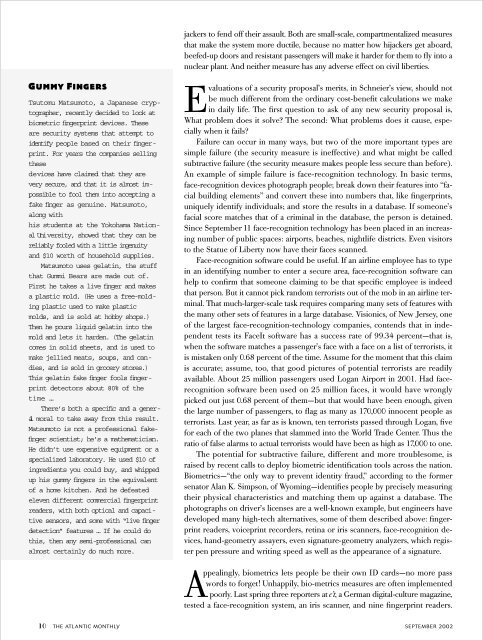HOMELAND INSECURITY - Charles C. Mann
HOMELAND INSECURITY - Charles C. Mann
HOMELAND INSECURITY - Charles C. Mann
Create successful ePaper yourself
Turn your PDF publications into a flip-book with our unique Google optimized e-Paper software.
Sept-Insecurity.pages 6/28/02 10:37 AM Page 10<br />
G UMMY FINGERS<br />
Tsutomu Matsumoto, a Japanese cryptographer,<br />
recently decided to look at<br />
biometric fingerprint devices. These<br />
are security systems that attempt to<br />
identify people based on their fingerprint.<br />
For years the companies selling<br />
these<br />
devices have claimed that they are<br />
very secure, and that it is almost impossible<br />
to fool them into accepting a<br />
fake finger as genuine. Matsumoto,<br />
along with<br />
his students at the Yokohama National<br />
University, showed that they can be<br />
reliably fooled with a little ingenuity<br />
and $10 worth of household supplies.<br />
Matsumoto uses gelatin, the stuff<br />
that Gummi Bears are made out of.<br />
First he takes a live finger and makes<br />
a plastic mold. (He uses a free-molding<br />
plastic used to make plastic<br />
molds, and is sold at hobby shops.)<br />
Then he pours liquid gelatin into the<br />
mold and lets it harden. (The gelatin<br />
comes in solid sheets, and is used to<br />
make jellied meats, soups, and candies,<br />
and is sold in grocery stores.)<br />
This gelatin fake finger fools fingerprint<br />
detectors about 80% of the<br />
time …<br />
There’s both a specific and a general<br />
moral to take away from this result.<br />
Matsumoto is not a professional fakefinger<br />
scientist; he’s a mathematician.<br />
He didn’t use expensive equipment or a<br />
specialized laboratory. He used $10 of<br />
ingredients you could buy, and whipped<br />
up his gummy fingers in the equivalent<br />
of a home kitchen. And he defeated<br />
eleven different commercial fingerprint<br />
readers, with both optical and capacitive<br />
sensors, and some with “live finger<br />
detection” features … If he could do<br />
this, then any semi-professional can<br />
almost certainly do much more.<br />
jackers to fend off their assault. Both are small-scale, compartmentalized measures<br />
that make the system more ductile, because no matter how hijackers get aboard,<br />
beefed-up doors and resistant passengers will make it harder for them to fly into a<br />
nuclear plant. And neither measure has any adverse effect on civil liberties.<br />
Evaluations of a security proposal’s merits, in Schneier’s view, should not<br />
be much different from the ordinary cost-benefit calculations we make<br />
in daily life. The first question to ask of any new security proposal is,<br />
What problem does it solve? The second: What problems does it cause, especially<br />
when it fails?<br />
Failure can occur in many ways, but two of the more important types are<br />
simple failure (the security measure is ineffective) and what might be called<br />
subtractive failure (the security measure makes people less secure than before).<br />
An example of simple failure is face-recognition technology. In basic terms,<br />
face-recognition devices photograph people; break down their features into “facial<br />
building elements” and convert these into numbers that, like fingerprints,<br />
uniquely identify individuals; and store the results in a database. If someone’s<br />
facial score matches that of a criminal in the database, the person is detained.<br />
Since September 11 face-recognition technology has been placed in an increasing<br />
number of public spaces: airports, beaches, nightlife districts. Even visitors<br />
to the Statue of Liberty now have their faces scanned.<br />
Face-recognition software could be useful. If an airline employee has to type<br />
in an identifying number to enter a secure area, face-recognition software can<br />
help to confirm that someone claiming to be that specific employee is indeed<br />
that person. But it cannot pick random terrorists out of the mob in an airline terminal.<br />
That much-larger-scale task requires comparing many sets of features with<br />
the many other sets of features in a large database. Visionics, of New Jersey, one<br />
of the largest face-recognition-technology companies, contends that in independent<br />
tests its FaceIt software has a success rate of 99.34 percent—that is,<br />
when the software matches a passenger’s face with a face on a list of terrorists, it<br />
is mistaken only 0.68 percent of the time. Assume for the moment that this claim<br />
is accurate; assume, too, that good pictures of potential terrorists are readily<br />
available. About 25 million passengers used Logan Airport in 2001. Had facerecognition<br />
software been used on 25 million faces, it would have wrongly<br />
picked out just 0.68 percent of them—but that would have been enough, given<br />
the large number of passengers, to flag as many as 170,000 innocent people as<br />
terrorists. Last year, as far as is known, ten terrorists passed through Logan, five<br />
for each of the two planes that slammed into the World Trade Center. Thus the<br />
ratio of false alarms to actual terrorists would have been as high as 17,000 to one.<br />
The potential for subtractive failure, different and more troublesome, is<br />
raised by recent calls to deploy biometric identification tools across the nation.<br />
Biometrics—“the only way to prevent identity fraud,” according to the former<br />
senator Alan K. Simpson, of Wyoming—identifies people by precisely measuring<br />
their physical characteristics and matching them up against a database. The<br />
photographs on driver’s licenses are a well-known example, but engineers have<br />
developed many high-tech alternatives, some of them described above: fingerprint<br />
readers, voiceprint recorders, retina or iris scanners, face-recognition devices,<br />
hand-geometry assayers, even signature-geometry analyzers, which register<br />
pen pressure and writing speed as well as the appearance of a signature.<br />
Appealingly, biometrics lets people be their own ID cards—no more pass<br />
words to forget! Unhappily, bio-metrics measures are often implemented<br />
poorly. Last spring three reporters atc’t, a German digital-culture magazine,<br />
tested a face-recognition system, an iris scanner, and nine fingerprint readers.<br />
10 THE ATLANTIC MONTHLY SEPTEMBER 2002




